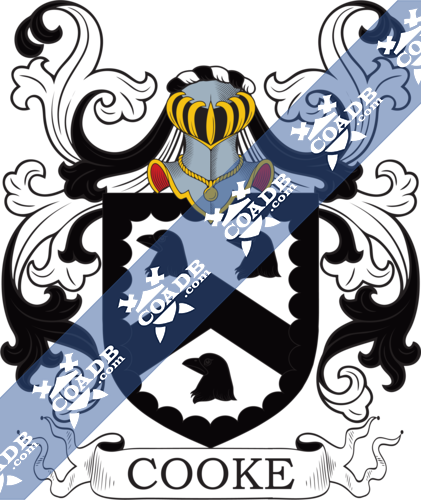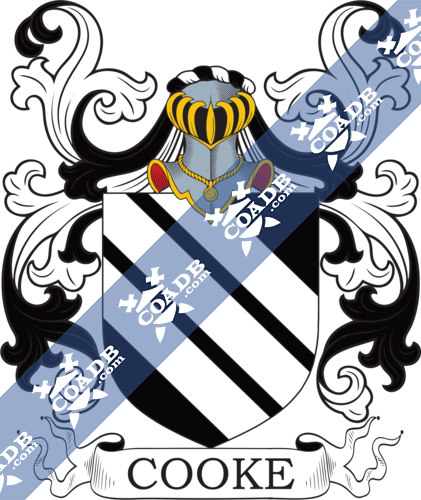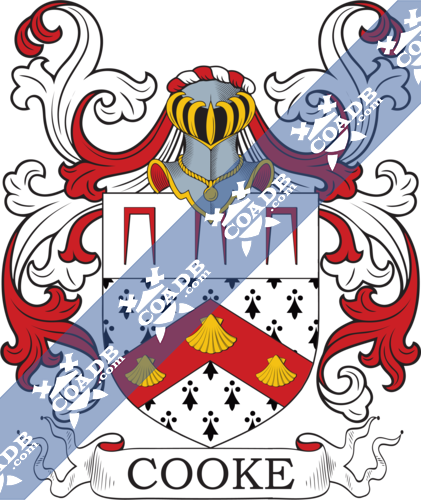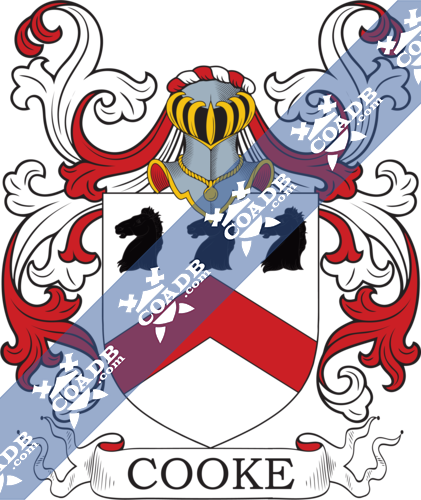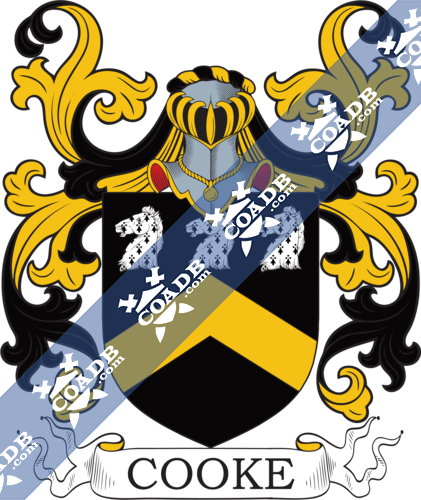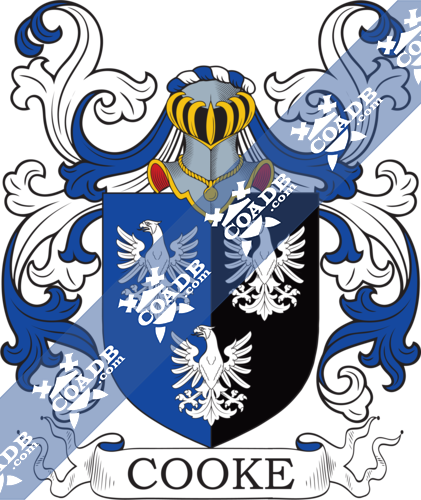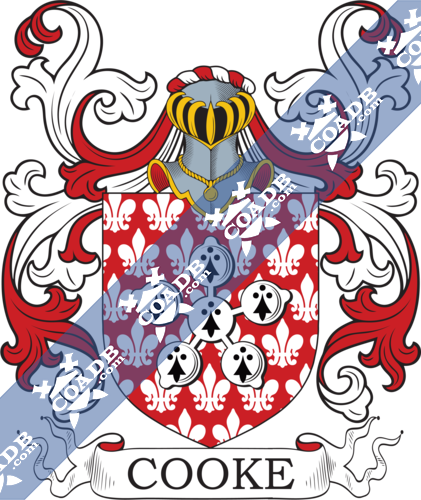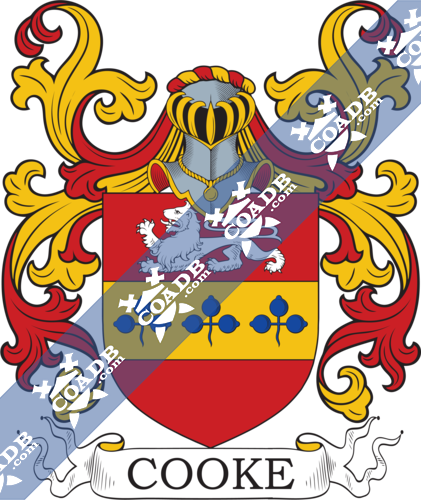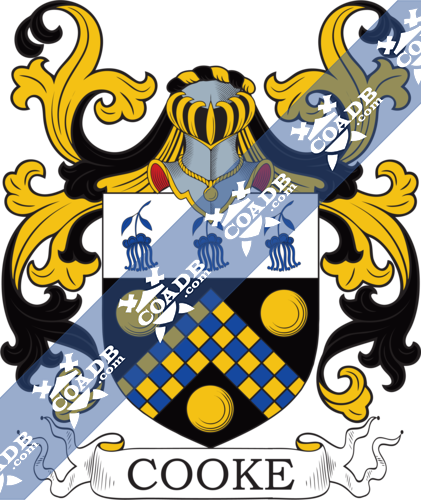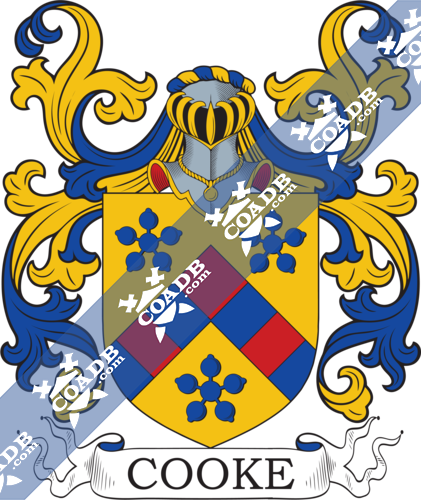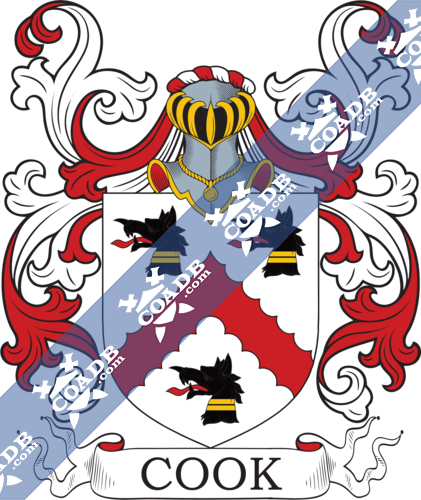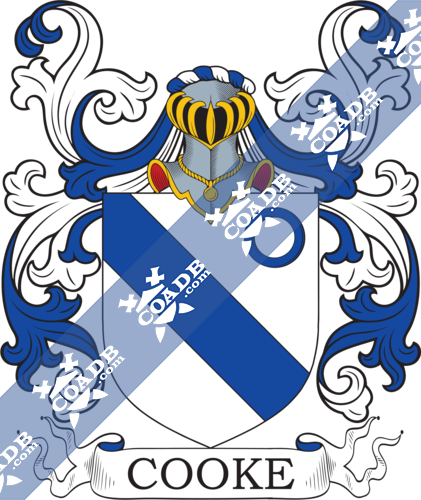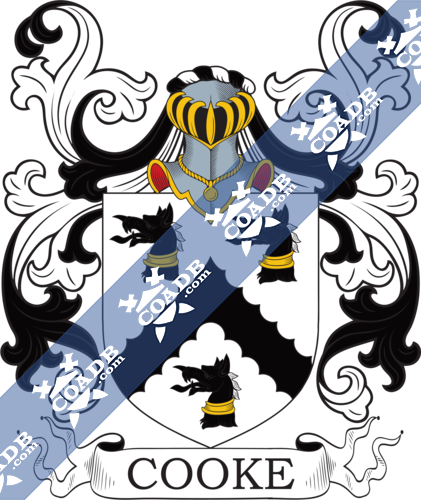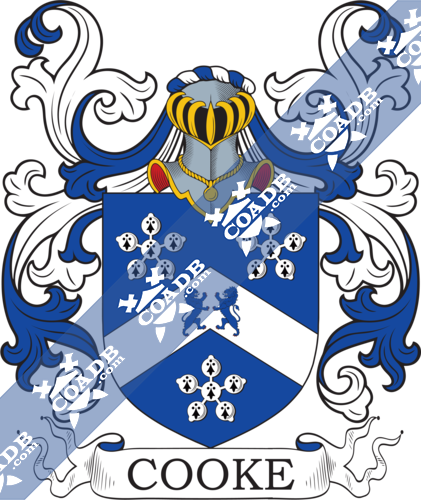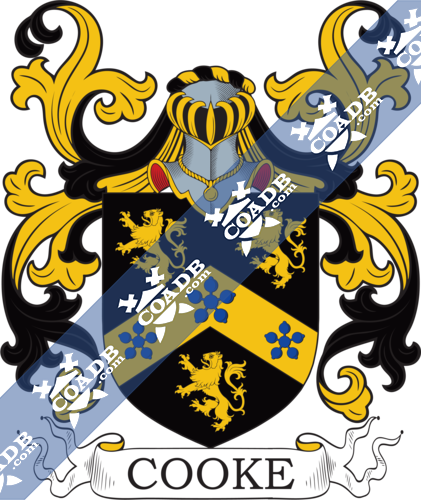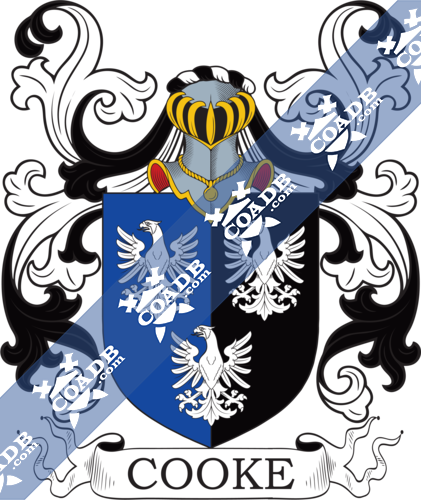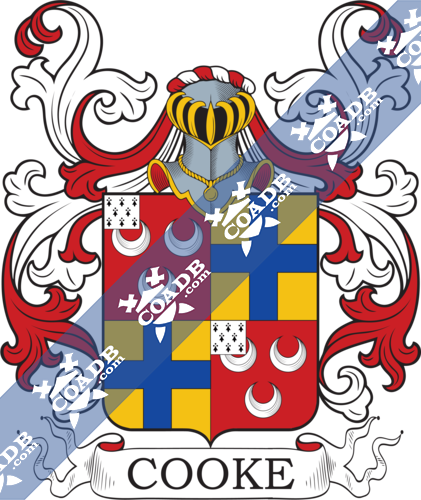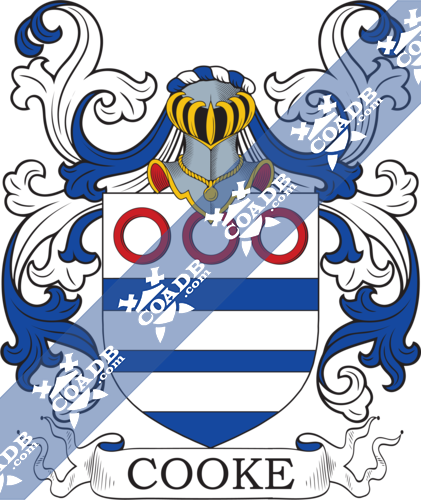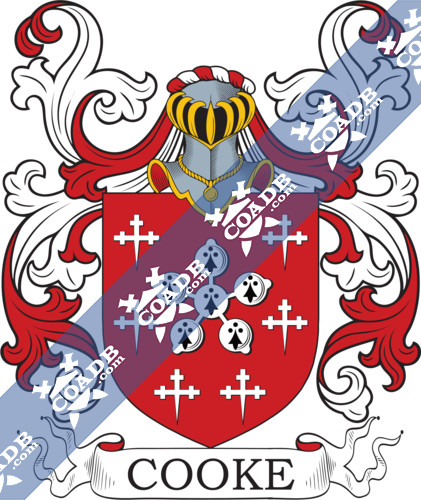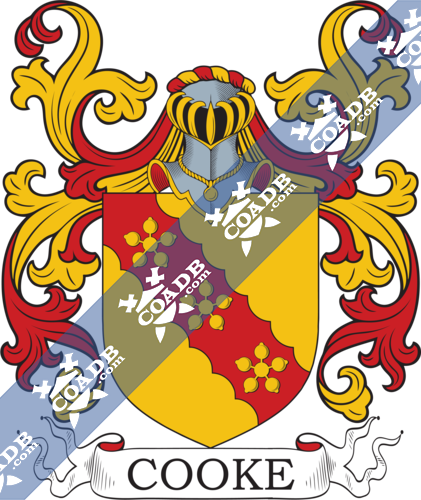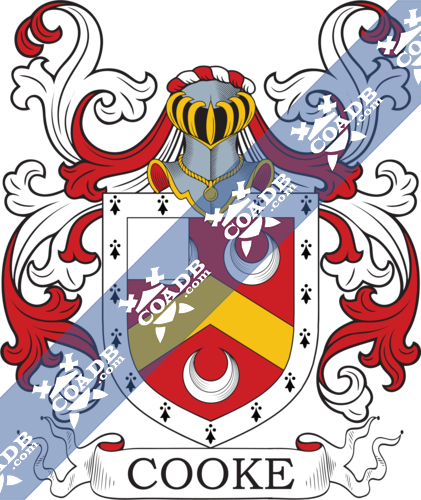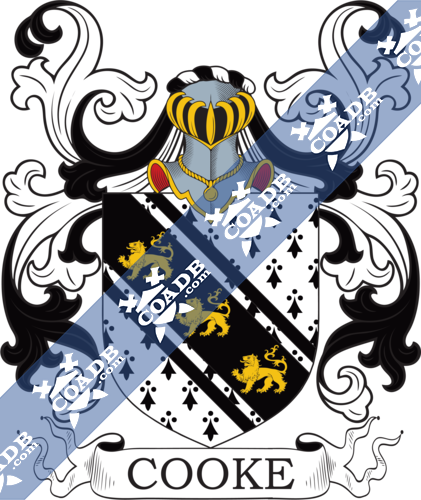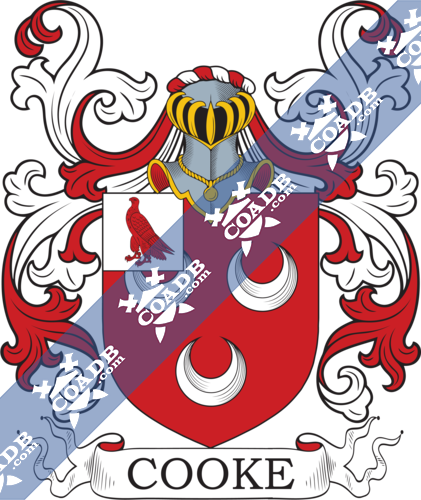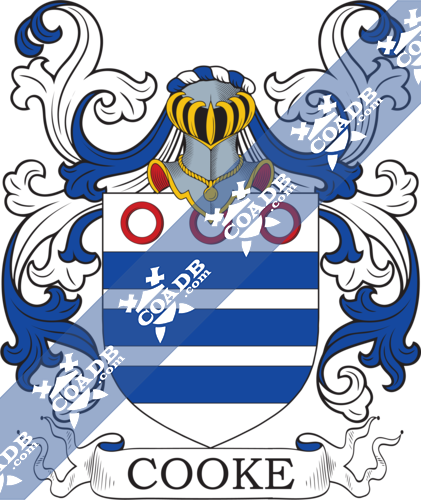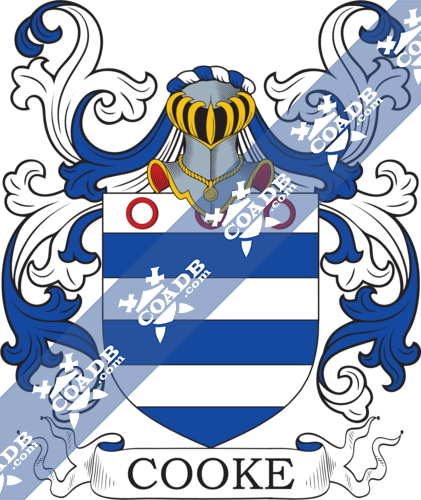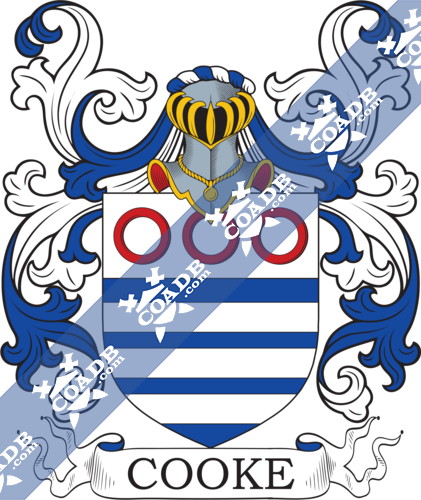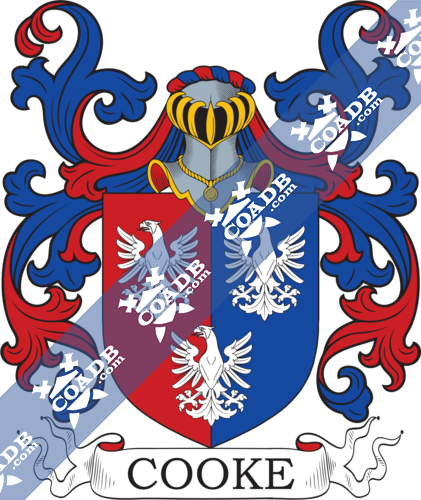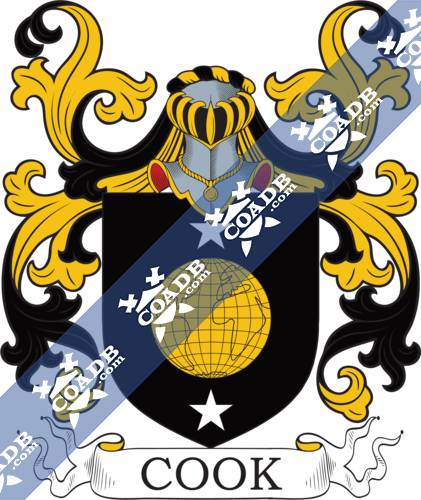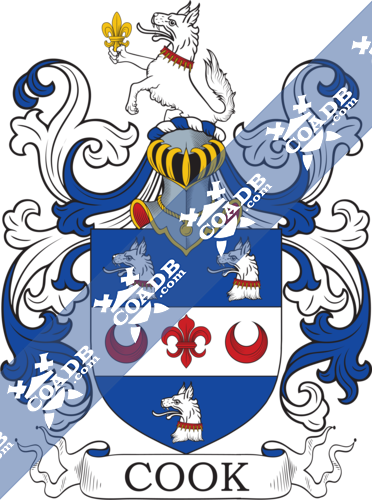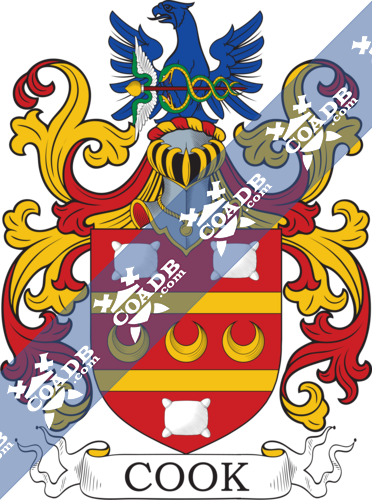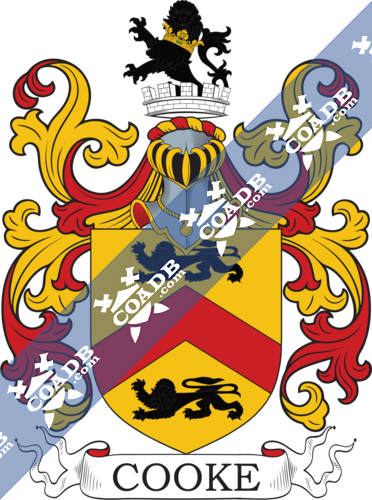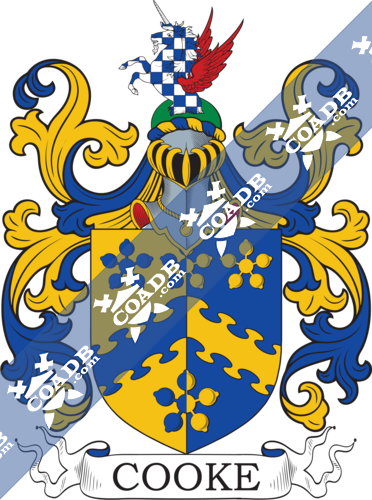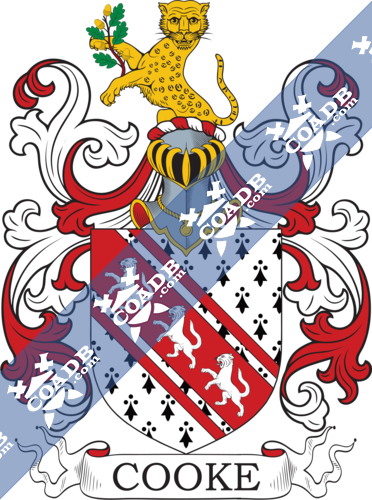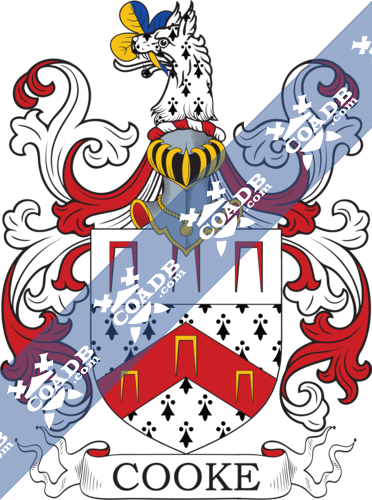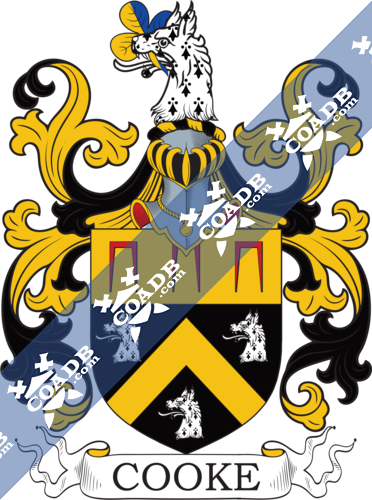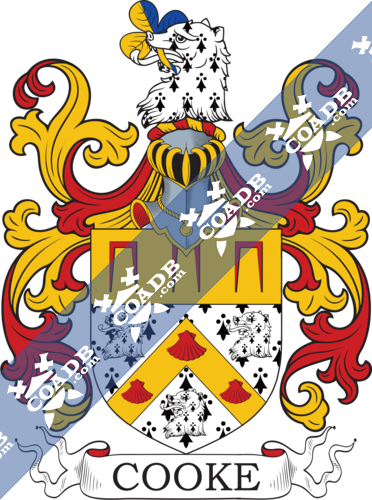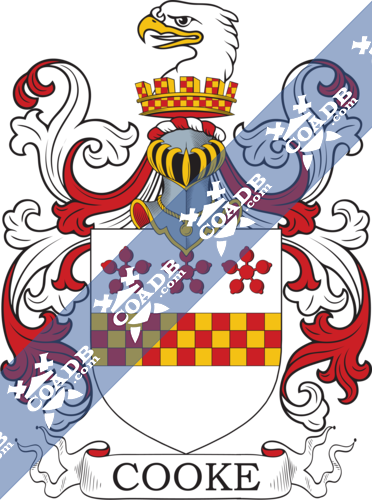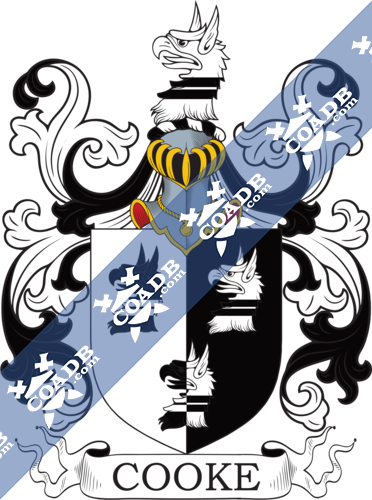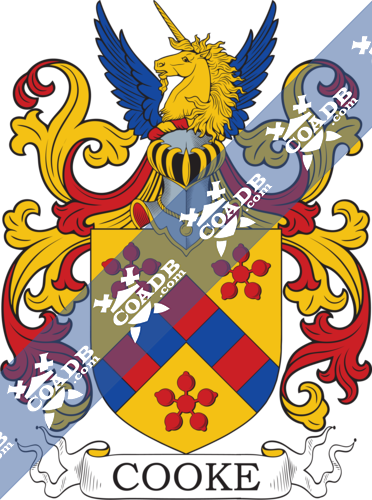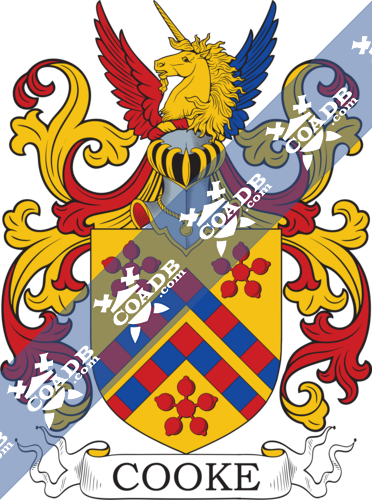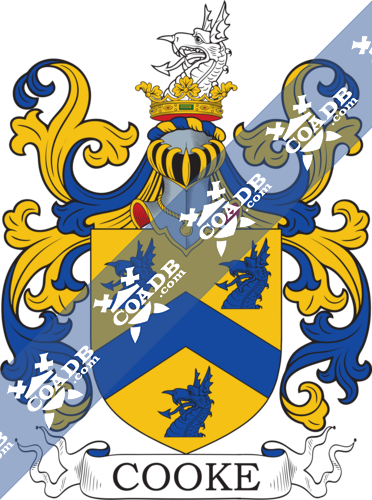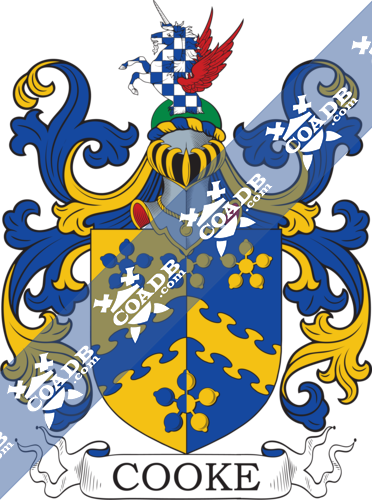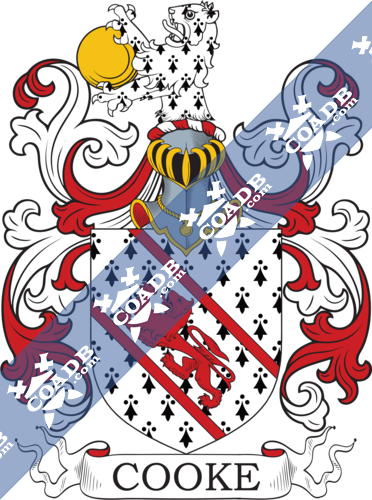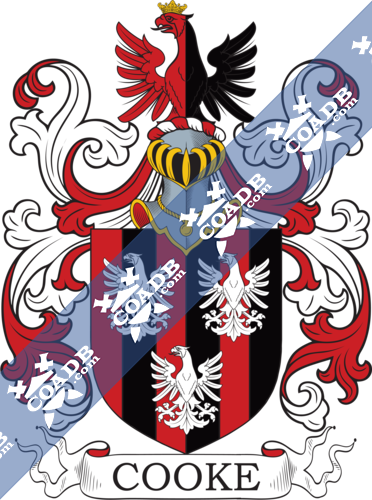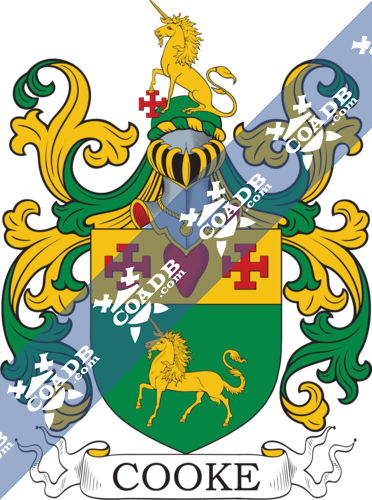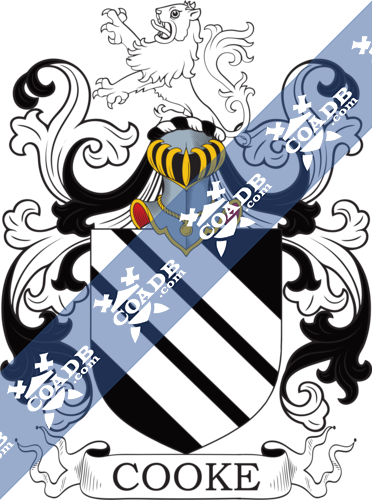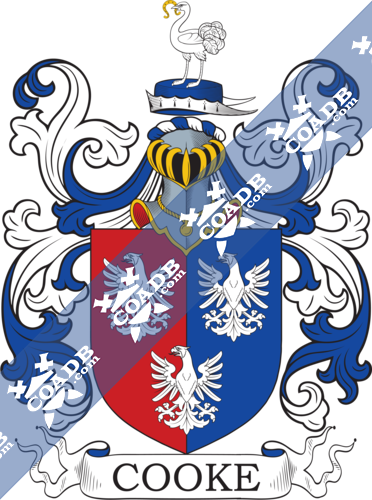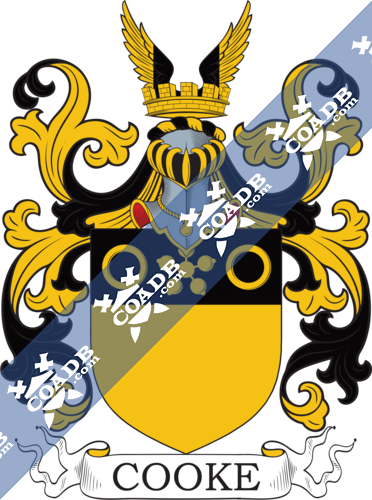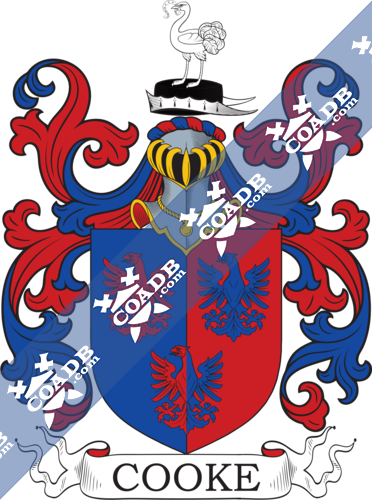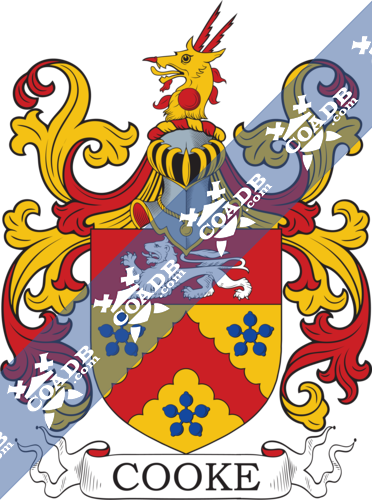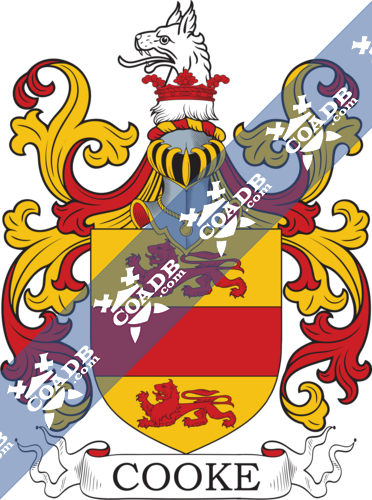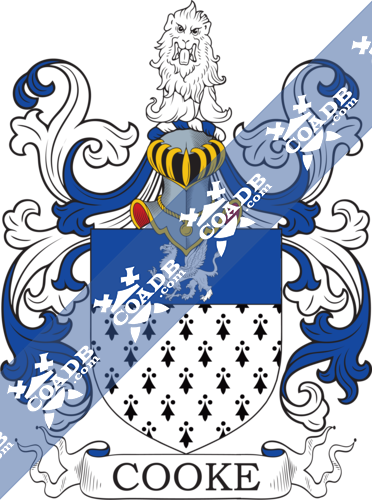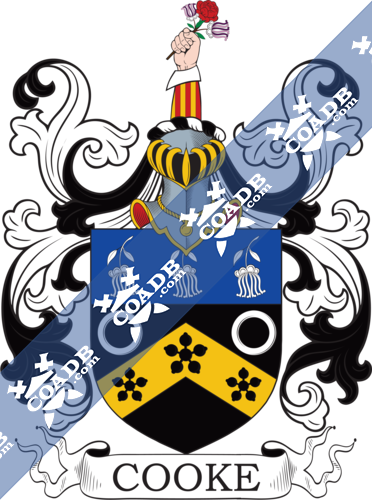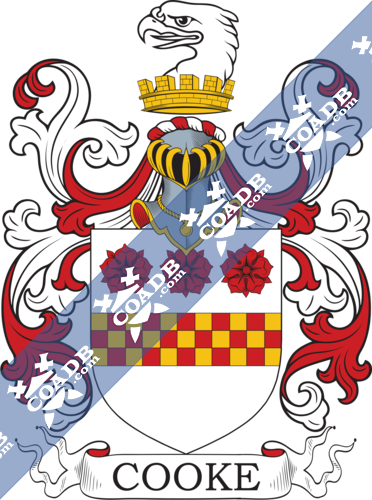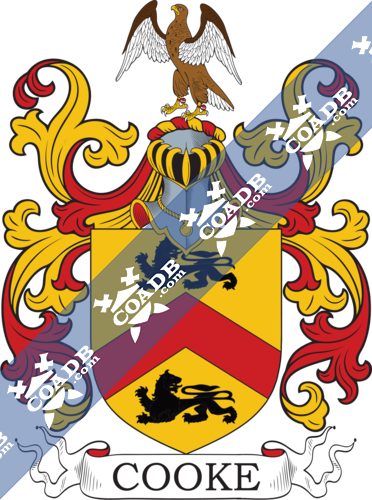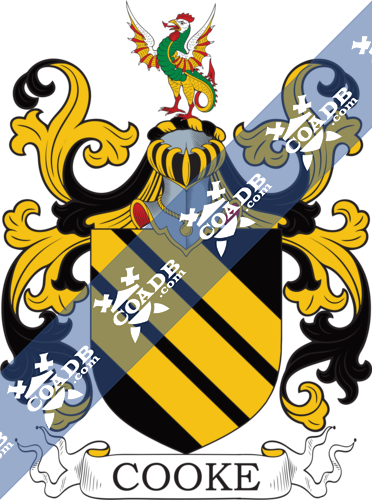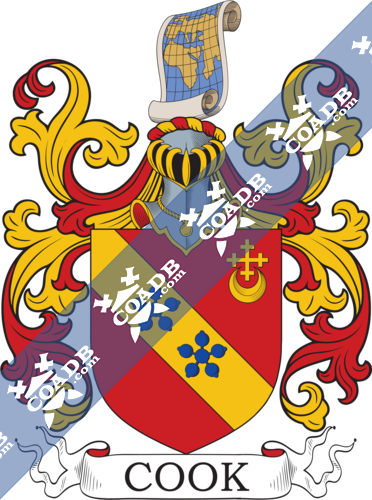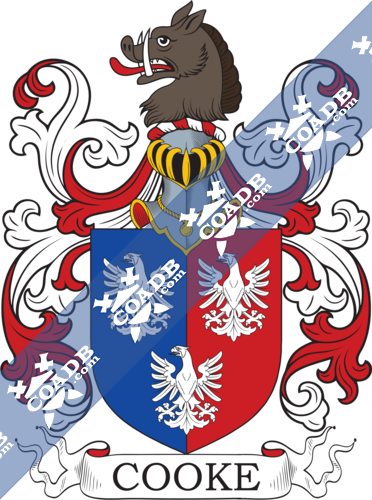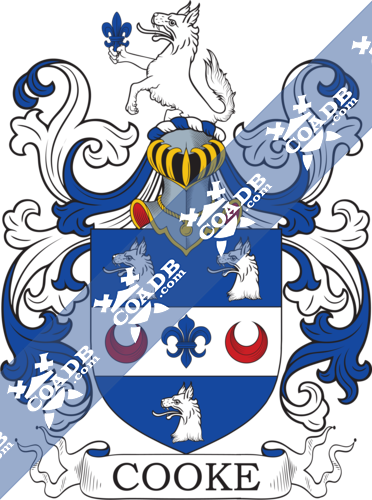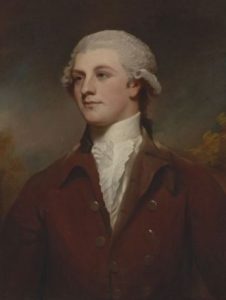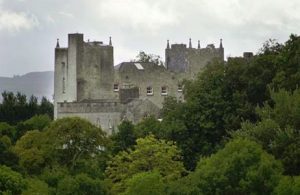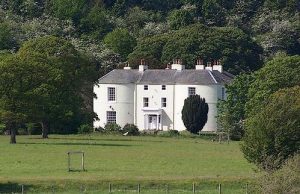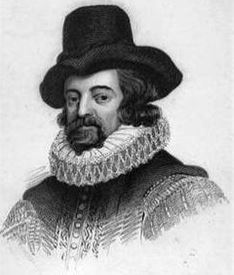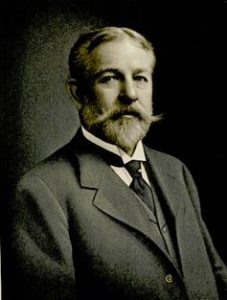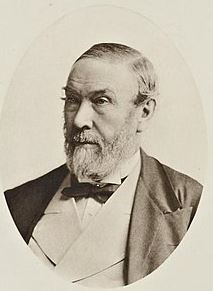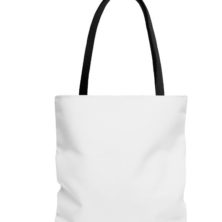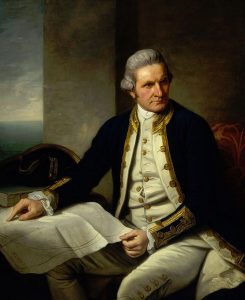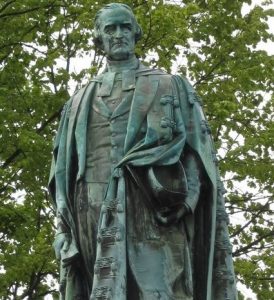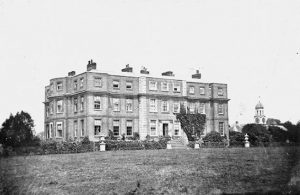Cook Family Crest, Coat of Arms and Name History

Cook Coat of Arms Gallery
Don’t know which Coat of Arms is yours?
We can do a genealogical research. Find out the exact history of your family!
Learn MoreSurname Name Meaning, Origin, and Etymology
This is an English, Scottish, and Irish occupational surname meaning “the cook”, meaning someone who baked goods such as pies for sale, or cooked meats for sale, with the earliest spelling being Coke. It could also have referred to the person who owned or kept an eating house (modern day restaurant). It derives from the Old English word coc, which in turn derives from the Latin word cocus or coquss, which means a cook. It can also be an Anglicized version of the Gaelic surname MacCug or McCook, meaning “the son of Hugo”. Lastly, it is an erroneous translation of the last name Lecuyer, a French surname.
Spelling Variations
Common spelling variants or names with similar etymologies include Cooke, Cocus, Coke, McCook, and MacCug. There are other foreign names that sound or are spelled similar: Koch, Kok, Cock, Cocks, Cox, Cuono, Kuharic, Kuvaric. There are also several other names where cook surnames as the base of the word, such as Pennycook, Cooksey, and Cookson (“the son of Cook”, from Settle in Yorkshire, originally).
Popularity & Geographic Distribution
The last name ranks Cooke ranks 60th in popularity in terms in the United Status as of the 2000 Census. The name ranks particularly high in the following six states: West Virginia, Georgia, Michigan, Missouri, Oregon, Kansas, Iowa, and Wyoming. The surname is even more common in England, where it ranks 66th. It ranks highest in the following counties: Suffolk, Bedfordshire, and Essex. The name is common throughout the English speaking world: Scotland (129th), Wales (66th), Ireland (1,908th), Canada (103rd), New Zealand (77th), Australia (53rd), and South Africa (569th). The 1890 book Homes of Family Names by H.B. Guppy, states the following in regard to this surname: “Most frequent in the south-central counties of England and in the eastern coast counties from Lincoln to Kent (excluding Essex). Comparatively scarce in the north and in the south-west of England. The counties most characterised by the name are Beds, Cheshire, Gloucester, Kent, Lincolnshire, Norfolk, Northamptonshire, Notts, Oxfordshire, Shropshire, Suffolk, Surrey, and Worcestershire”.
Early Bearers of the Surname
The earliest known bearer of this surname was Aelfsige thene Coc who was documented in the Anglo-Saxon Wills Records in around 950 AD. Walter le Kuc was documented in the Assize Rolls of Somerset in 1279 AD. Richard Cok was listed in the Assize Rolls of Staffordshire in 1269 AD. A one Galter Coc was recorded in Essex in the Domesday Book of 1086 AD, which was a survey of England and Wales ordered by William the Conqueror. The Hundred Rolls of 1273 AD, a census of Wales and England, known in Latin as Rotuli Hundredorum lists four bearers of this surname: John Cocus in county Norfolk, Alexander Cocus in county York, Emma Coca in county Cambridgeshire, and Matthew Cocus in county Oxfordshire. An early baptism involving this surname was Rachael, daughter of John Cooke, at St. Dionsis Backchurch. An early marriage involving this last name was Dorothee Cooke to Edmund Shoard in 1631 at the same aforementioned church. The Writs of Parliament list one Roger le Cook around 1300 AD.
History, Genealogy, and Ancestry
The famous genealogist Bernard Burke’s book “The Landed Gentry” discusses five branches of this family: 1) Cooke of Owston, 2) Cooke-Collis of Castle Cooke, 3) Cooke of Kiltinan, 4) Cooke of Knockgraffon, and 5) Cooke of Camerton.
The first begins with a mention of Philip Bryan Davies-Cooke, Esquire of Owston, county York, Gwysaney, county Flint, and Haford-y-wen, county Denbigh. He was a Justice of the Peace, Deputy Lieutenant, and High Sheriff of county Flint in 1858. He was born in 1832 and succeeded his father in 1853. In 1862, he married Emma Julia, daughter of Sir Tatton Sykes, and had six children with her: Philip Tatton (1863), Henry George (1867), Mary Helena, Emma Katharine, Mildred Emily, and Helena Frances Anna. Burke traces the genealogy or ancestry of this family back to Henry Cooke, the second son of Sir Henry Cooke, the 2nd Baronet of Wheatley, who purchased lands from the Adams family in Owston and was seated there. He married Anne, daughter of Reverend Ralph Eaton, and died in 1717 whereupon he was succeeded by his son Bryan. Bran was an Esquire of Owston, Recorder of Doncaster. He died and his estates devolved to his brother, Anthony Cooke, Esq. born in 1710. He married Mary, daughter of Anthony Eyre, and had a son and heir with her named Bryan. This Bryan was born in 1765 and was Colonel 3rd West York Militia and High Sheriff of Denbigh in 1794, as well as a Member of Parliament for Malton. He married Frances, daughter of Philip Puleston, and had issue with her: Philip Davies, Rev. Robert Bryan, Anthony Henry (of the Royal Navy), William Bryan, and Mary Frances (married Reverend William Margesson in 1818). He was succeeded by his eldest son: Philip Davies Cooke. Philip was a Justice of the Peace, Deputy Lieutenany, and High Sheriff for county Flint in 1824. He was born in 1793 and in 1829 he married Lady Helena Caroline King, daughter of George, 3rd Earl of Kingston, and had children with her: Philip Bryan, Bryan George Davies-Cooke, Reverend George Robert Davies-Cooke, James Robert Davies-Cooke, Helen Francis Adelaide, and Adelaide Flora Frances Isabella. He died in 1853. The Cook Coat of Arms has the following blazon in heraldry: Or, a chevron gules between two lions passant-guardant sable, quartering, with many others Puleston, Davies, King, Fitzgerald, Fenton, and the White Knight.
The second branch begins with a discussion of Reverend Maurice Atkin Cooke-Collis, D.D. of Castle Cooke in county York and Rector of Queenstown who was born in 1812. In 1839, he married Anne, daughter of Reverend John Talbot, of Ardfert Abbey, and had several children with her: William (Captain in the 83rd regiment, born 1847), John Talbot (educated at Pem. College, born 1849), Maurice Crosbie (1850), Jane Lloyd (married Nathaniel Cox Barton and later James Erskine Oliphant), Geraldine De Courcy (married Augustus P. Barton), Annie Talbot Crosbie, and Emma Theodosia. Burke traces the pedigree and lineage of this family back to Peter Cooke, a resident in Cork, Ireland before the war of 1641. He married a woman named Margaret and had several sonds with her: Thomas, Robert, Edward, and Peter. His eldest son was Thomas. Thomas had children named Thomas, Peter, Zachard, and Anne. The eldest son was Thomas. This Thomas was a very wealth merchant in the city of Cork and was in the Society of Quakers. In 1661, he married Joan Harwood, and he later married Beatrix Datchelor. He was adjudged as a traitor for adhering the cause of King William III. His estates passed on to his only son: Peter Cooke, Esquire of Castle Cook in county Cork. In 1696, Peter married Elizabeth Mitchell and had three children with her: Thomas, Zachary, and Elizabeth (married John Collis). Thomas was the eldest son and had three daughters himself, and he was succeeded by his brother Zachary, who died without issue and was in turn succeeded by his niece: Martha Cooke. Martha married her cousin, the Reverend William Collis, Rector of Church Hill and Kilgobben, and had issue with her. Their eldest son was Reverend Zachary-Cooke Collis, Archdeason of Cloyne, who succeeded the estate of Castle Cooke and assumed the surname and arms of Cooke.
The third branch begins with a discussion of Robert Cooke, Esq. of Kiltinan Castle in county Tipperary who was a Justice of the Peace and Deputy Lieutenant. In 1864, he married Henrietta, daughter of John Cornwall of Brownstown House. He succeeded his grandfather in 1849. Burke traces the lineage or genealogy back to Edward Cooke, the son of the first Peter Cooke and brother of Thomas, ancestor of the family mentioned in the previous paragraph. His eldest son was named John. John was one of the Commissioners named in the statutes of William III. He in turn had a son and heir named Robert. Robert in turn had a son named Edward. Edward was an Esquire of Kilitnan Castle, who married Abygaile Green and had a son with her named Robert Cooke, as well as a daughter named Frances who married Lieutenant Colonel John Jackson Glover. Robert married Hannah, daughter of Sir Richard Wheeler-Cuffe, Baronet of Leyrath, and had issue with her. His heir was John, who married Jane, sister of John Congreve, and had issue with her: Robert (mentioned at the beginning of this paragraph), Reverend Ambrose, Edward, Frederick, John (Captain 3rd Hussars), Wheeler, Anne, and Louisa. The Cooke Family Crest has the following blazon in heraldry: Per pale, gules and azure, three eaglets displayed argent.
The fourth branch discussed begins with a mention of Reverend John Cooke of Knockgraffon in county Tipperary who was educated at Balliol College Oxford. He was born in 1819 and in 1847, he married Ellen Durham, daughter of the late Sir Joseph Huddart of Brynkir, county Carnarvon, and had a son with her named Joseph who was born in 1850. Burke traces the Cooke genealogy of this branch back to Peter Cooke, Esquire, who was the youngest son of the first Peter Cooke, and brother of the ancestors of Castle Cooke and Kyltinan families. In 1687, Peter purchases the castle and lands of Knockgraffon (also called Farronshonick) from Sir Fenton Aylmner. He owned iton mines and lands of Arraglin. He was succeeded by his son Joseph, Esq. of Arraglin who was born in 1669. Joseph married a member of the Butler family and had two sons with her: John and William. He later married Ann Boyce and had issue with her as well: Joseph, Samuel, and Reverend Peter. He died and was succeeded by his son John Cooke, Esq. of Cordangan who was an Alderman of Yougal. John married Elizabeth Hobbs and had issue with her. His son was Joseph who married Anne Garnot, and had issue with her including an heir named John. This John Cooke was Barrister-at-Law, Justice of the Peace, and Deputy Governor of county Tipperary. In 1783, he married Mary, daughter of Nicholas Taylor (Esq. of Antigua) and had issue with her, including a son and heir named Joseph. His son Joseph was born in 1787 and was Justice of the Peace and Deputy Lieutenant. In 1818, he married Jane Scott, daughter of Thomas Rodie of Liverpool, and had five issue with her: John (mentioned at the beginning of this paragraph), Thomas Rodic (1823), Joseph Henry (1826), Elizabeth Matilda, and Mary Jane.
The fifth branch discussed is begins with a mention of Elizabeth Cooke of Camerton, Cumberland, who was the daughter and co-heiress of Ralph Cooke, Esquire of Camerton. The lineage is traced to Ralph Cooke, who in 1719, purchased the manor or Lordship of Camberton or Camberton, the mansion of Camerton Hall, and demesne, lands, and other items in the parishes of Camberton and Isell from Joseph Curwen. He had children Richard and Elizabeth (who married Reverend Curwen Huddlestone). His son and heir Richard was born in 1702 and in 1731 he married Elizabeth, daughter of John Stanley of Dalegarth and Ponsonby) and had two children with her: Ralph and Dorothy (married Reverend William Thomas Addison). His son and heir was Ralph, Esquire of Camerton who in 1778, married Frances, eldest daughter of George Dawson of Untank in Cumberland, and had four children with her: Ralph, George (born 1782, Brigage-Major and Senior Captain in 96th regiment in the Island of St. Croix who married Mary Corden), Richard (1787), and Elizabeth (who died as in infant). His successor was Ralph who was born in 1780. In 1806, Ralph married Catherine, the daughter of Humphrey Senhouse. They had three sons (Ralph, George, and William) and five daughters together. His heir was William, Esq. of Camerton. William was born in 1822 and died in 1866. His co-heiress was Catharine (his sister) who in 1875, married J.C. Blanchard of Leamington and Isabel (his sister) who married Henry Falcon. Isabel and Henry had several issue, including the heir presumptive, Tom Harrison (born 1841, Lieutenant in the Royal Navy).
The Cooke Coat of Arms had the following heraldic blazon: Or, a chevron gules between two lions passant regardant. The arms of the surname Falcon are also present.
Robert Coke or Cooke should also be mentioned. He was born in Mileham, Norfolk, England in 1513. He married Winifred Knightley with whom he had a son named Edward. His son Edward gave rise to numerous bearers of this surname.
Josias or Joshiah Cook(e) was born in 1610 and married Elizabeth Ring in Plythmouth, MA. They had three issue: Anne (Snow), Bethia (Harding), and Josiah Jr. His son Josiah Jr. was born in 1645 in Plymouth or Eastham. He married Debirah Hopkins and had ten children with her: Elizabeth, Josiah III, Richard, Elizabeth, Caleb, Deborah (Godfrey), Joshua, Benjamin, and Martha. His son Joshua was born in 1782. He married Patience Doane and had the following issue with her: Martha, Josiah, Mercy, Ebenezer, Ephraim, Ruhama, Simeon, and Moses. His son Ephraim Cooke or Cook was born in 1712 in Barnstable, MA. He married Mary Merrick and had a son with her named Moses. Moses was born in 1738 and he married Eunice Allin in 1760 in Connecicut. They had a son named James who was born in 1763 in New Marlborough. He married Eunice Looms and had two sons with her: John and Nathan. Nathan Cook was born in 1800 in New York and he married Permelia Hadlock with whom he had seven children: Asa Jane, James, Nathan, Lois, Elizabeth, Joseph William, and Euphemia L. His son James was born in 1821. He married Permlia Cole and later Mary A. Poole and had the following children: Mercy P., Emmeline, Sarah, Frank M., Gertrude, and Frederick M. His son Frank was born around 1860 in Ohio. His son Frederick was born around 1864 in the same state.
Early American and New World Settlers
The book Genealogical Guide to the Early Settlers, mentions 21 people bearing this surname:
1) Aaron Cooke of Dorchester, a freeman in May of 1635 who moved to Windsor and married a daughter of Thomas Ford with whom he had the following issue: Joanna (1638), Aaron (1641), Miriam (1643), Moses (1645), Samuel (1650), Elizabeth (1653), Noah (1657). He graduated at Mussaco.
2) Caleb Cook of Watertown, MA who married in 1685, Mary Parmenter and had a son with her also named Caleb in 1686
3) Elkanah Cook (Boston 1658)
4) Francis Cook of Plymouth who came in the Mayflower in 1620, with one child, John: his wife Esther, and other children Jacob, Jane, and Ester who came aboard the Ann in 1623. In American, he had a daughter named Mary. He owned six shares of land and seven shares at division of cattle. Governor Bradford referred to him as a “very old man” in 1650. He was one of the first purchasers of Dartmouth and Middleborough. His daughter Jane married Experience Mitchell , Ester married Richard Wright, and Mary married John Thomson.
5) George Cook of Cambridge, came in the Defence in 1635 at the age of 12 with his older brother Joseph. He was a freeman in 1636 and a representative in 1636-1645, as well as a captain in an artillery company. He married a woman named Alice, and had Elizabeth (1640), Thomas (1642), Joseph (1643), Elizabeth (1644), and Mary (1646). He went back to Ireland where he was a colonel and died there. His daughter Mary married Samuel Annesley, Esquire of Westminster.
6) Gregory Cook, of Cambridge, shoemaker, by wife Mary, had children Stephen (1647), Susanna (1674),
7) Henry Cook, of Salem in 1638 who married Judith Bursdall in the following year. He had the following children: Isaac, Samuel, John, Judith, Rachel, Mary, Martha, Henry, and Hannah.
8) Isaac Cook of Salem, who in May 1664, married Elizabeth, daughter of Anthony Buxton, had Elizabeth (1665), Isaac (1667), and Mary (1668).
9) James Cook of Boston who died in 1690
10) John Cook of Plymouth in 1633, who removed to Rehoboth 1643. It is likely he moved to Warwick and became town-sergeant in 1651. He had children named John and Elizabeth. Elizabeth married John Harried in 1666.
11) John Cook of Salem, 1637, who might have came in the Abigail in 1635 at the age of 27 and was a freeman in 1642.
12) John Cook of Ipswich in 1664
13) John Cook of Portsmouth, Rhode Island. He might have had a wife named Ruth and had several sons and daughters. In 1647, he was made one of two “water bailies” of the Colony.
14) John Cook of Boston was of the vestry of King’s Chapel in 1689. The same John (likely) was a solider in the company of Moseley in 1675, and again in Philip’s War, 1676 at Hadley, may have of been Gloucester.
15) John Cook of Middleton who died in 1705 and left children John, Mary, Daniel (14), Sarah (12), and Ebenezer. He had a wife named Hannah, daughter of Captain Daniel Harris.
16) John Cook of Hampton who married Mary Downs in 1686.
17) Joseph Cook of Cambridge, the elder brother of George, came to America aboard the Defense in 1635 at the age of 27. He came from Earl’s Colne, in Essex. He was a representative from 1636-1640 and member of an artillery company in 1640. He married Elizabeth and had children Elizabeth (1645), Grace (1648), Grace (1650), and Ruth, who were all baptized at Cambridge.
18) Joseph Cook of Wells, who swore allegiance in 1680.
19) Josiah Cook of Plymouth who in 1635 married Elizabeth, daughter of Mary King, and widow of Stephen Deane. He moved to Eastham with Governor Prence and had Josiah, Ann (married Mark Snow), and Bethia (who married Joseph Harding).
20) Nathaniel Cook of Windsor, who in 1649, married Lydia, daughter of Richard Vote, who had Sarah (1650), Lydia (1653), Hannah (1665), Nathaniel (1658), Abigail (1660, John (1662), and Josias (1664). He was a freeman of Connecticut in 1650 and died in 1688.
21) Peyton Cook of Saco in 1635, a gentleman, was clerk of the assembly of Lygonia in 1648.
22) Philip Cook of Cambridge, who was a freeman in 1647, and married Mary, daughter of Barnabas Lamson. He had issue: Mary (1652), Philip (1654), Samuel & Hannah (1657), and Sarah.
23) Ralph Cook of Charlestown in 1640 who had a wife named Sarah, admission of the church November 30th, 1643.
24) Richard Cook of Charlestown came aboard the Jonathan in 1639, at the age of 31. He lived on Malden side. His wife was named Francis and he had a daughter Mary born in May of 1649. He was “of friends of Marmaduke Matthew’s preaching” and died in October 1658. His wife had children by a former husband: Thomas, Isaac, Elizabeth, Sarah, and Wheeler. His daughter Mary married Samuel Green in 1666.
25) Richard Cook of Boston was a tailor from Gloucestershire and was a freeman in 1643. He served in an artillery company in 1643 and a lieutenant in 1656. He was also a representative for Dover in 1670. He married Eliabeth and had issue: Elhanan (1636), Elisha (1637), Elkanah (1640), and others.
26) Richard Cook of Norwhuich who had grant of land in 1680 and in the part now Preston, and son Obed, born in 1681.
27) Robert Cook of Charlestown was a freeman in 1641. He had a wife named Sarah with whom he had a son named Samuel, born in 1644.
28) Robert Cook of Portsmouth, Rhode Island, who in 1678, married Tamar, daughter of John Tyler of Bristol, had children Mary (1682), Miriam (1689), and Samuel (1695).
29) Roger Cook of Marshfield in 1642
30) Samson Cook of Gloucester, who died in January 1674
31) Samuel Cook of Dedham 1640, called a gentleman of Dublin, Ireland
32) Samuel Cook, of New Haven, CT. In 1667, he married Hope, daughter of Edward Parker, nad had children: Samuel (1668), John (1669), and a daughter.
33) Stephen Cook of Mendon, a freeman in 1647, perhaps the brother of Gregory. He moved to Watertown, Massachusetts, and was one of the founders of the second church, a deacon, and died April 24, 1714.
34) Thomas Cook of Salem who died in 1650
35) Thomas Cook of Taunton 1639, proprietor with Thomas Jr. in 1643, probably both moved to Portsmouth, Rhode Island, and was called captain in 1659 with commission to run the West line of the Colony
36) Thomas Cook of Watertown, who had a daughter before 1647, and may be the mariner who died in Boston in 1646
37) Thomas Cook of Guilford who had two children: Thomas Jr. and Sarah, the latter married Thomas Hall. His second wife was Hannah Lindon. He died in December 1692.
38) Thomas Cook of Windsor of whom no connection with any other name is known. He had a wife and a daughters named Mary and Martha.
39) Thomas Cook of Braintree, one of a military watch in 1689
40) Walter Cook, Weymouth 1643 who was a freeman in 1653. He had three issue: Ebenezer (1656), Walter (1657), and Nicholas (1660).
41) William Cook of Maine in 1665. Eleven people of this name recorded, some with the letter E at the end of the surname. Many graduated from Harvard and Yale, and many were clergymen.
A one Joseph Cooke came to Virginia aboard the Bonaventure in January 1634. William Cooke came to Virginia aboard the Transport in 1635.Garret Cooke came to Virginia aboard the Primrose in July 1635. Edward Cooke went to St. Christopher’s in October 1635 aboard the John. A one Thomas Gribell Cooke came to Virginia aboard the Friendshipe of London in 1636. A one Arthur Cooke was recorded among the dead in Virginia in 1623, as was George Cooke. A one Ellin Cook came to Virginia in the London Marachant in June 1620 at the age of 25. A one Christopher Cooke came in 1621 aboard the George at the age of 25. A one Mathew Cooke was associated with Monmouth’s Rebellion of 1685 and was a prisoner transported to Taunton. Sarah Cook was buried in the parish of St. Michael’s in Barbados in August of 1678. A one Jeremiah Cook (owned 5 slave and had 6 servants) lived in Barbados in 1680.
Later Colonial Americans bearing this name include Abraham Cook (Virginia 1701), Libby Cook (Virginia 1704), and Francis Cook (Virginia 1705). One of the earliest settlers in Canada bearing this surname was Charles Cook, who came to Nova Scotia with his wife and two children in 1749. One of the earliest settlers in Australia bearing this name was Henry Cook, an English convict from Middlesex, who came to New South Wales in 1820 aboard the Agamemnon.
Early American Bearing the Cook Family Crest
Henry Francis Cook was born in Brooklyn, New York in 1855. In 1883, he married Lena Marianne, daughter of Joseph Fahys of Brooklyn, and had the following issue with her: Joseph Fays (1888), Henry (1892), Francis Howell (1899), Edith Eloise, Maria Fahys, and Madeleine Huntting. He bore the following arms: Ermine, on a bend cotised gules three cats-a-mountain argent. He was the son of Henry Cook of London.
Jay Cooke Jr. was born in Philadelphia in 1845. In 1868, he married Clara Alice, daughter of Joel Barlow Moorhead. They had two issue together: Jay Cooke (who married Nina Louise Benson) and Caroline Clara (married Robert Wilder Bush). He bore the following coat of arms: Or, a chevron gules between two passant guardant sable. He was the son of Jay Cooke of Sandusky, Ohio and Dorothea Elizabeth Allen.
Edward Cook of Stafford England (1800-1859) settled in New York. He bore the following Cook family crest: Or, a chevron engrailed gules between three cinquefoils azure, on a chief of the second a lion passant argent.
George Cooke, grandson of Thomas Cooke of Pebmarsh, Essex lived in Cambridge, Massachusetts. He bore the following arms: Sable, three bends argent.
Mottoes
We have identified 13 Cook or Cooke family mottoes:
1) Tutum monstrait iter, meaning “He shows the safe way”
2) Vici, meaning “I have conquered”
3) Nec timeo, nec sperno, meaning “I neither fear nor despise”
4) Pro Tege et patria, meaning “For king and country”
5) Vis courageux fier, meaning “Strong, brave, and proud”
6) Omnia vincit labor, meaning “Labour conquers all things”
7) Pro patria, meaning “For my country”
8) Tu ne cede malis, sed contra audentior ito, meaning “Yield not to misfortunes, but go the more boldly against them”, for Cooke of Cordangan, from Virgil
9) Nihil habere sinc labore, “To have nothing without labour”
10) Virus ardua petit, meaning “Valour seeks for difficulties”
11) Cook of Owston bore the motto of Davies of Gwynsaney: Da Domine quod jubes, et jube vis, meaning “Give what thou commandest and command what thou wilt”.
12) Pejus letho flagitium timeo, meaning “” (Cooke of Kiltinan)
13) Vif, courageous, fier, meaning “Spirited, courageous, proud” (Cooke of Cameron through Falconer).
Grantees 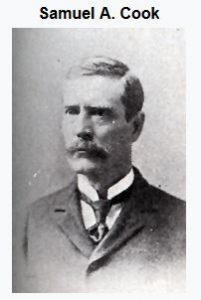
We have 84 coats of arms for the Collins surname depicted here. These 84 blazons are from Bernard Burke’s book The General Armory of England, Ireland, and Scotland, which was published in 1848. The bottom of this page contains the blazons, and in many instances contains some historical, geographical, and genealogical about where coat of arms was found and who bore it. People with this last name that bore a Cook Coat of Arms include:
1) John Cook of the Inner Temple, 27 January 1679-80, by Sir W. Dugdale
2) Nycholas Cooke of Lynstead, Suffolk, gift 1561
3) Sir Philip Cooke of Essex
4) Ralph Cooke of Bristwo, Surrey, D.D. and rector there, 12 August 1662 1556
5) Sir Richard Cooke, Secretary for the State for Ireland and Chane, confirmed 20 July 1612 by Camden
6) Marmaduke Cooke, Preb. of York, son of Robert
7) William Cooke, LL.D., chancellor to Bishop of Ely
8) Richard Cooke, Broomhall, Suffolk, a person well descended and allied, and a loyal subject, 26 July 1662, by Sir E. Walker, Gart
9) Robert Cooke of Mildham, Norfolk, gentleman, granted 10 or 9 June
10) Robert Cooke, Clar. King of Arms, grant 4 March 1597-8 by Flower
11) Robert Cooke of Langham, Suffolk, 1 May 1612 by Camden
12) Thomas Cooke, Redmarley Oliver, county Worcestershire, fourth son of Thomas, 2nd s. of John, of Norfolk, by Cooke, confirmed or testified by Segar
13) William Cooke, of Cotton, Suffolk, gift 1561 (Harvey’s Grants)
14) Thomas Cook, Haberdasher, of London, Argent a lion passant on bend between two cotises gules, on a chief azure two stars or, by Segar
15) William Cook, of Middlesex, 15 November 1550, by Hawley (?)
16) Bryan Cooke of Doncaster, confirmed 27 August 1635
17) Edmond Cooke of Lozenes in Kent, son and heir of Henry of Broadwater, Sussex, 6 September 1574 by Cooke
18) Edward Cooke of Mildham, Suffolk, by Cooke
19) Sir George Cooke, 1st Baronet, Wheatley, Yorks, 27 January 1679-1680, by W. Dugdale
20) John Cook, Exeter, Devon, 19 November 1677
21) John Cooke, son of George of Giggleswick, Yorkshire, 6 June 1653 by Ryley, Clar. (?), confirmed 1662
22) John Cooke of Fulwell Hatch, Essex, Esquire, of the body to King Henry VIII, by T. Wriothesley, 1541
23) John Cooke, gentleman, 20 February 6 1551-2 by G. Dethick
Notables
There are thousands of notable people with the Cook(e) surname. This page will mention a handful. Famous people with this last name include: 1) Captain James Cook (1728-1779) who was a British explorer, cartographer, and Captain in the Royal Navy who was the first recorded European to make contact with the Hawaiian Islands and eastern Australia, 2) John Cook (1730-1789) who was the Governor of Delaware, 3) Paula Cook (1969) who is an English auto racing driver born in Roterham, 4) Robert Brian “Robin” Cook (1940) who is an American doctor and novelist, 5) Roger Hugh Cook (1965) who is an Australian politician who became Deputy Premier of Western Australia in 2017, 6) Samuel Andrew Cook (1849-1918) who was a U.S. Representative from Wisconsin, 7) Roderick Cook (1932-1990) who was an English playwright, director, and actor known for Oh, Coward! And Amadeus, and 8) Barbara Cook (1927) who is an American actress and singer from Atlanta, GA known for starring in several Broadway musicals (ex. The Music Man 1957).
Blazons & Genealogy Notes
1) (Sir Samuel Cook, Lord Mayor of Dublin 1713, was knighted 10 Jan. that year.) Az. on a fess betw. three wolves’ heads erased ar. collared gu. studded or, a fleur-de-lis betw. two crescents of the third. Crest—A demi wolf ar. collared gu. studded or, holding in the dexter paw a fleur-de-lis of the last.
2) (Bedfordshire). Quarterly, purp. and ar. in sinister chief a horseshoe. Crest—An ostrich, holding in the beak a horseshoe ar.
3) (London; Her. Off. Int. MSS. Vincent, No. 154). Ar. a lion pass. in bend betw. two cottises gu. on a chief az. as many estoiles or. Crest—A demi lion gu. holding out in his gamb an estoile or.
4) (Mildham, co. Norfolk). Ar. a chev. engr. gu. betw. three tigers’ heads erased sa. langued of the second, each charged on the neck with a gemel or.
5) (Northumberland and Yorkshire). (Doncaster, co. York; confirmed 27 Aug. 1635). Or, a chev. betw. two lions pass. guard. sa. Crest—A demi lion pass. guard. sa. ducally gorged or.
6) (Kingsthorp, co. Northants, granted by St. George, Garter, and Vanbrugh, Clarenceux, to the surviving issue of Francis Cook, of Kingsthorp, 1711). Per pale az. and gu. three eagles displ. and armed or, guttee de poix, cach having about his neck a collar sa. Crest—An eagle displ. or, guttee de poix, armed sa., having about his neck & like collar.
7) (Pittenweem, Scotland). Gu. on a bend or, two cinquefoils az. on a sinister canton a cross crosslet issuing out of a crescent, of the second. Crest—A sea chart ppr. Motto—Tutum monstrat iter.
8) (Edinburgh, 1876). The same Arms within a bordure or. Same Crest and Motto.
9) (Capt. Cook, the circumnavigator). Sa. a sphere or, betw. two mullets in pale ar.
10) (Brooklands, Blackheath Park, co. Kent). Gu. three crescents in fesse within two barrulets or, betw. three woolpacks, two and one, ar. Crest—A caduceus fesseways ppr. in front of a demi eagle couped az. Crest—Omnia vincit labor.
11) (Visit. London, 1568. Thomas Metcalf, citizen and goldsmith of London, m Alice, dau. of Thomas Cook, of Tanton). Az. on a chev. engr. ar. betw. two chevronels or, and three cinquefoils pierced erm. two lions combatant purp.
12) (Wheatley, co. York, bart.). Or, a chev. gu. betw. two lions pass. guard. sa. Crest—Out of a mural crown ar. a demi lion guard, issuant sa. gorged with a ducal coronet or.
13) (Owston, co. York, descended from Henry, second son of Sir Henry Cooke, second bart. of Wheatley, and now represented by Philip Bryan Davies Cooke, Esq., of Owston and Gwysaney, son and heir of Philip Davies Cooke, Esq., by Lady Helena Caroline King, dau. and eventually coheir of George, 3rd Earl of Kingston, and grandson of Bryan Cooke, Esq., M.P., of Owston, by Frances his wife, dau. and heir of Philip Puleston, Esq., by Mary his wife, dau. and co-heiress of John Davies, Esq., of Gwysaney). Or, a chev. gu. betw. two lions pass. guard. sa. quartering Puleston, Davies, King, Fenton, the White Knight, &c. Crest—Out of a mural crown ar. a demi lion guard, sa. ducally gorged or.
14) (Rev. Thomas Alexander Cooke, Esq., of Wargrave, co. Berks, adopted by sign manual, 1850, the name of Cooke, in lieu of that of Mathews). Per pale or and az. a chev. nebule, betw. three cinquefoils in chief, and one in base counterchanged. Crest—On a mount vert a demi unicorn erased, chequy ar. and az. winged gu.
15) (co. Devon, and Trerice, co. Cornwall. Visit. 1620). Erm. on a bend cottised sa. three cats pass. guard. or. Crest—A demi cat ramp. guard. or, holding an oak branch vert, fructed of the first.
16) (co. Devon). Ar. a chev. betw. three ravens’ heads erased sa. within a bordure engr. of the second.
17) (Thorne, co. Devon; the heiress m. Misson). Erm. on a bend cottised gu. three cats-a-mountain, ar. Crest—A demi leopard guard. or, supporting a branch of oak fructed or.
18) (Fullwell Heath, co. Essex). Erm. on a chev. gu. three door-staples or, on a chief ar. as many door-staples of the second. Crest—A wolf’s head erased erm. holding in the mouth a trefoil slipped per pale or and az.
19) (Fullwell, co. Sussex). Sa. a chev. or, betw. three wolves’ heads erased erm. on a chief or, as many door-staples gu. Crest, as the preceding.
20) (Fulwell-Hache, co. Essex). Erm. on a chev. or, betw. three bears’ heads erased erm. as many escallops gu. on a chief of the second three door-staples of the third. Crest—A bear’s head erased erm. holding in the mouth a trefoil slipped, per pale, or and az.
21) or Cook – (Little Staybridge, co. Essex). Sa. three bends ar.
22) (Essex). Erm. on a chev. gu. three escallops or, a chief ar. charged with as many staples of the second.
23) (Essex). Ar. a chev. gu. in chief three nags’ heads, erased, sa.
24) (Essex). Sa. a chev. or, three horses’ heads in chief erm.
25) (Clifton, near Bristol). Ar. a fesse chequy or and gu. in chief three cinquefoils of the last. Crest—Out of a mural coronet chequy or and gu. an eagle’s head ar. beaked or. Motto—Vici.
26) (William Cooke, Esq., of Lincoln’s Inn). Per pale ar. and sa. three griffins’ heads erased and counterchanged, each charged on the neck with a bar gemell. Crest—A griffin’s head, as in the arms.
27) (Lancashire). Per pale az. and sa. three eagles displ. ar.
28) (Robert Cooke, Esq., Clarenceux King of Arms, 1567). Gu. semee-de-lis … a cinquefoil erm.
29) (Brome Hall, co. Norfolk, bart, created 1663, extinct 1708). Gu. on a fesse or, three trefoils az. in chief a lion pass. ar.
30) (Giddea Hall, Essex). Or, a chev. compony gu. and az. betw. three cinquefoils of the second. Crest—A unicorn’s head or, betw. two wings, endorsed, az.
31) (Alresford, co. Hants). Gu. three crescents or, a chief of the last quartering the arms of Sayer, and Baker. Crest—A dexter arm erect, ppr. encircled with a wreath of laurel vert, the hand bolding an estoile ar.
32) (granted 1843 to John Cooke, Esq., of The Chase, co. Hereford;. Or, two chevronels compony gu. and az. betw. three cinquefoils of the second. Crest—A unicorn’s head or, betw. two wings endorsed compony gu. and az.
33) (Kent). Sa. on a chev. or, betw. three plates, as many cinquefoils of the field, on a chief ar. three columbines ppr.
34) (Kent). Sa. a chev. chequy or and az. betw. three bezants, on a chief ar. as many columbines of the third.
35) (Kent, and Broadwater, co. Sussex). Gu. three crescents ar. a canton of the second. Crest—On a mount vert a beaver pass. or.
36) (Lord Mayor of London, 1462). Or, a chev. componee gu. and az. betw. three cinquefoils of the third.
37) (London). Or, a chev. az. betw. three dragons’ heads couped and erect of the second. Crest—Out of a ducal coronet or, a dragon’s head erect ar.
38) (Wargrave, co. Berks. Rev. Thomas Alexander Cooke), Per pale or and az. a chev. nebulee betw. three cinquefoils in chief, and one in base, all counterchanged. Crest—On a mount vert a demi-unicorn erased chequy ar. and az. winged gu. Motto—Nec timeo, nec sperno.
39) (London). Erm. a lion pass. in bend betw. two cotises gu. Crest—A demi lion ramp. and erased erm. holding betw. his gambs a bezant.
40) (London). Paly of six gu. and sa. three eagles displ. ar. Crest—A demi eagle, per pale gu. and sa., with wings displ. and ducally crowned or.
41) (London, and Harefield, co. Middlesex). Ar. a bend az. in the sinister corner an annulet of the last.
42) (Edmonton. co. Middlesex, granted 7 June, 1760). Vert, a unicorn pass, or, on a chief of the last a human heart betw. two crosses potent gu. Crest—On a mount vert a unicorn sejant or, resting the dexter foot on a cross potent gu.
43) (Middlesex). Sa. three bends ar. Crest—A demi lion ramp.
44) (Mildham, co. Norfolk). Ar. a chev. engr. betw. three tigers’ heads sa. maned of the first, collared or.
45) (Norfolk). Per pale gu. and az. three eagles displ. ar. Crest—On a chapeau az. turned up erm. an ostrich ar. holding in the mouth a horseshoe or.
46) (Norfolk). Or, on a chief sa. a cinquefoil betw. two annulets of the field. Crest—Out of a mural coronet or, two wings expanded per pale gold and sa.
47) (Norfolk). Az. on a chev. ar. betw. three cinquefoils erm. two lions combatant of the field armed gu.
48) (Mildham, co. Suffolk). Per pale az. and gu. three eagles diapl. counterchanged. Crest—On a chapeau sa. turned up erm. an ostrich close ar. in the beak a horseshoe of the last.
49) (Linstead, co. Suffolk). Or, a chev. engr. gu. betw. three cinquefoils az. on a chief of the second a lion pass. ar. Crest—An antelope’s head erased or, charged with torteaux, tusked, horned, and tufted, gu.
50) (Cotton, co. Suffolk). Sa. on a chev. betw. three lions ramp. or, as many cinquefoils az.
51) (Whitefield, co. Suffolk). Or, a fesse betw. two lions pass. gu. Crest—A wolf’s head ar. ducally gorged gu.
52) (Langham, co. Suffolk). Gu. an inescutcheon ar. betw. four crosses formee fitchee, in saltire or.
53) (Burstow, co. Surrey; granted 20 August, 1662). Per pale az. and sa. three eagles displ. ar.
54) (Langham, co. Suffolk). (Peake, co. York, founded by Sir Thomas Cooke, Knt., Lord of the Manor of Hackney, co. Middlesex, and Governor of the East India Company). Erm. on a chief az. a griffin pass. ar. Crest—A lion’s head erased guard, ar.
55) (Sussex). Gu. three crescents ar. a canton erm., quartering, or, a cross az., for De Bohun.
56) (Mylton, co. Warwick). Per pale ar. and sa. three wolves’ heads erased, counterchanged, collared gu. Crest—A wolf’s head per pale gu. and or, gorged with two bars counterchanged.
57) (co. Worcester). Ar. two chev. betw. six martlets gu. three, two, and one. Crest—Out of a mural coronet or, an arm embowed in armour ppr. garnished of the first holding a sword ar. hilt gold, on the arm two chevs. gu.
58) (Claines, Redmorley, Oliver, and Staunton, co. Worcester. Thomas, son of Thomas Cooke, of Claines, and grandson of John Cooke, Esq. of Harples, co. Norfolk, recorded his descent in Visit. 1634, d. 1641, confirmed 1869, to W. H. Cooke, Esq. of the Green, Shalsley Kings). Or, a fesse betw. two lions pass. gu. Crest—An heraldic tiger’s head erased ar. ducally gorged gu. studded of the first. Motto—Pro Tege et patria.
59) (co. York). Per pale ar. and sa. three greyhounds’ heads erased, collared, and counterchanged.
60) (co. Cambridge; granted by Hamley, Clarenceux, 5 Elizabeth). Arms same as preceding. Crest—A greyhound’s head couped per pale or and gu. gorged with two bars counterchanged.
61) (co. York). Gu. three crescents and a canton or.
62) Sa. on a chev. or, three cinquefoils of the first, in chief two annulets ar. on a chief az. three columbines of the third. Crest—An arm erect, vested paly of six or and gu. holding in the hand a bunch of columbines and roses ar. cuffed ppr.
63) Ar. a fesse chequy or and gu. in chief three roses of the last. Crest—Out of a mural coronet or, an eagle’s head ar.
64) (Camerton, co. Cumberland). Or. a chev. gu. betw. two lions pass, reguard. sa. Crest—A falcon rising ppr. Motto—Vis courageux fier.
65) (granted 20 July, 1612). Az. two bars ar. on a chief of the second three annulets gu.
66) Sa. three bends or. Crest—A cockatrice with wings expanded.
67) Chequy erm. and sa. a lion ramp. gu. on a chief of the second a leopard’s face betw. two crosses crosslet fitchee or.
68) Per saltire or and az. four eagles displ. counterchanged.
69) Gu. a cinquefoil (another, three) erm. betw. six crosses crosslet fitchee ar.
70) Or, on a bend engr. gu. three cinquefoils of the field.
71) Gu. a chev. or, betw. three crescents ar. a canton of the last within a bordure erm.
72) Gu. three crosses crosslet fitchee and a chief engr. or.
73) (Broomyard, co. Hereford). Per pale az. and gu. three eagles displ. ar. Crest—A boar’s head erased ppr.
74) Erm. on a bend cotised sa. three lions pass. or.
75) Ar. a bend componee az. and gu. an annulet of the second.
76) or Coke – Ar. three bars az. in chief as many annulets gu.
77) (Lodgemore and Farmhill, co. Gloucester). Same Arms. Crest—A griffin’s head erased holding in the mouth an annulet.
78) (from the Fun. Ent. of Sir Richard Cooke, principal Secretary and Chancellor of the Exchequer in Ireland, who m. the dau. of Sir Christopher Peyton, Auditor of War, and d. 8 Sept. 1616). Barry of six ar. and az. in chief three annulets gu.
79) (Tinncrany, co. Kilkenny, granted 20 March, 1635, by Preston, Ulster, to Samuel Cooke, Esq., of that place, son and heir of Erasmus Cooke, eldest son and heir of Erasmus Cooke, Esq., of St. Edmonds Bury, co. Suffolk, descended from the Cookes, anciently owners of the Manor of Ubbeston, or Uppeston, in the latter co.). Pean on a chief az. a griffin pass. ar. Crest—A leopard’s head erased pean.
80) (Tomduff, co. Wexford, from the Fun. Ent. of tha dau. of Sir Walsingham Cooke, who d. in 1656, and was buried in St. Patrick’s Cathedral). Az. three bars ar. on a chief of the last as many annulets gu.
81) (from the Fun. Ent. of Doctor Edward Cooke, son of Allan Cooke, Esq., who d. in 1667, and was buried in St. Patrick’s Cathedral). Gu. three crescents ar. on a canton of the last a falcon close of the first.
82) formerly Coke – (Painstown, co. Carlow, descended from Clement Coke, sixth son of Sir Edward Coke, Lord Chief Justice of England, Anne dau. and heiress of Thomas Cooke, Esq., of Painstown, m. 1750, Sir Thomas Browne, Viscount Kenmare). Per pale gu. and az. three eagles displ. ar.
83) (Milicent, co. Kildare, exemplified to Thomas Trench, Esq., upon his assuming, by royal licence, in 1850 the name of Cooke, in lieu of Trench). Az. on a fesse betw. three wolves’ heads erased ar. a fleur-de-lis of the first betw. two crescents gu. Crest—A demi wolf ar. holding in his paws a fleur-de-liz az.

